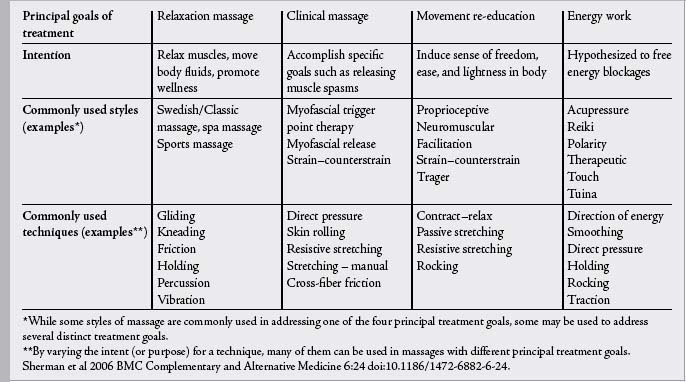Chapter One Understanding pain
Chapter contents
Introduction
This first chapter provides an overview of various types of pain. The content establishes a language for discussing pain and creates the structure for the following chapters. Massage therapy applied to address the symptoms and causes of pain can be very beneficial as long as the treatment is based on accurate information and safe and best practices. Bond (1984) describes pain as being a personal and unique experience which arises in the brain due to injury to the body tissue, disease, or due to biochemical changes in the body. Productive pain is an important protective mechanism when the pain response mechanism is working appropriately. The pain response can become maladaptive and therefore nonproductive.
Pain overview
Pain can be caused or exacerbated by stress, muscle tension, nerve damage, chemical imbalance, disordered breathing syndromes, nutritional disruption, side effects from medication, vascular dysfunction, sinus disorders, tumors, and many more internal and external influences. Pain management methods are targeted to alter these influences or shift the pain sensations. Research indicates potential for therapeutic massage to decrease stress and muscle tone, support more normal circulation of body fluids, and support effective breathing function. Massage may be able to reduce some side effects from pain medication. Massage therapy can also be used in a palliative manner substituting pleasurable sensations for the pain response. In Chapter 2 the research will be explored to support the benefits of massage.
Taxonomy (the science of classification) for pain
To understand treatment processes that target pain, it is necessary to delve deeper into pain mechanisms and pain management. As in many areas, the terminology that describes pain processes is confusing. The International Association for the Study of Pain supports a taskforce that is working on a more concise taxonomy (the science of classification) for pain (http://www.iasppain.org//AM/Template.cfm?Section=Home). See Box 1.1. The taxonomy for massage therapy is also confusing. Box 1.2 provides guidelines for massage therapy methods classifications.
Box 1.1 IASP pain terminology
NOTE: The pain terminology was modified and approved for publication by the IASP Council in Kyoto, November 29–30, 2007. The above pain terminology is reproduced with permission from Merskey H, Bogduk N (eds) 1994 Part III: Pain terms, a current list with definitions and notes on usage (pp 209–214). Classification of chronic pain, 2nd edn. IASP Task Force on Taxonomy, IASP Press, Seattle ®1994.
Causal factors of pain
When stimuli for other sensations, such as touch, pressure, heat, and cold, reach a certain intensity, they stimulate the sensation of pain as well. Excessive stimulation of a sensory organ causes pain. Additional stimuli for pain receptors include excessive distension or dilation of a structure, prolonged muscular contractions, muscle spasms, inadequate blood flow to tissues, or the presence of certain chemical substances. (Meldrum 2003)
Pain sensation
The point at which a stimulus is perceived as painful is called the pain threshold. This varies somewhat from individual to individual. One factor affecting the pain threshold is perceptual dominance, in which the pain felt in one area of the body diminishes or obliterates the pain felt in another area. Not until the most severe pain is diminished does the person perceive or acknowledge the other pain. This mechanism is often activated with massage application that produces a ‘good hurt.’
Pain tolerance refers to the length of time or intensity of pain that the person endures before acknowledging it and seeking relief. Unlike the pain threshold, pain tolerance is more likely to vary from one individual to another. A person’s tolerance to pain is influenced by a variety of factors, including personality type, psychological state at the onset of pain, previous experiences, socio-cultural background, and the meaning of the pain to that person (e.g. the ways in which it affects the person’s lifestyle). Factors that decrease pain tolerance include repeated exposure to pain, fatigue, sleep deprivation, and stress. Warmth, cold, distraction, alcohol consumption, hypnosis, and strong spiritual beliefs or faith, all act to increase pain tolerance.
Pain types
There are different types of pain and multiple ways to describe pain.
Somatic and visceral
• Surface somatic pain is perceived as sharp and may have a burning or pricking quality.
• When pain occurs in the musculoskeletal and fascial tissues, it is called deep somatic pain. Deep somatic pain is usually described as dull or aching but localized.
• Visceral pain is pain that originates in the organs of the body. It is often felt on the body surface in the classical referred pain patterns. It tends to be episodic and poorly localized (see Fig 1.1).
Stay updated, free articles. Join our Telegram channel

Full access? Get Clinical Tree










